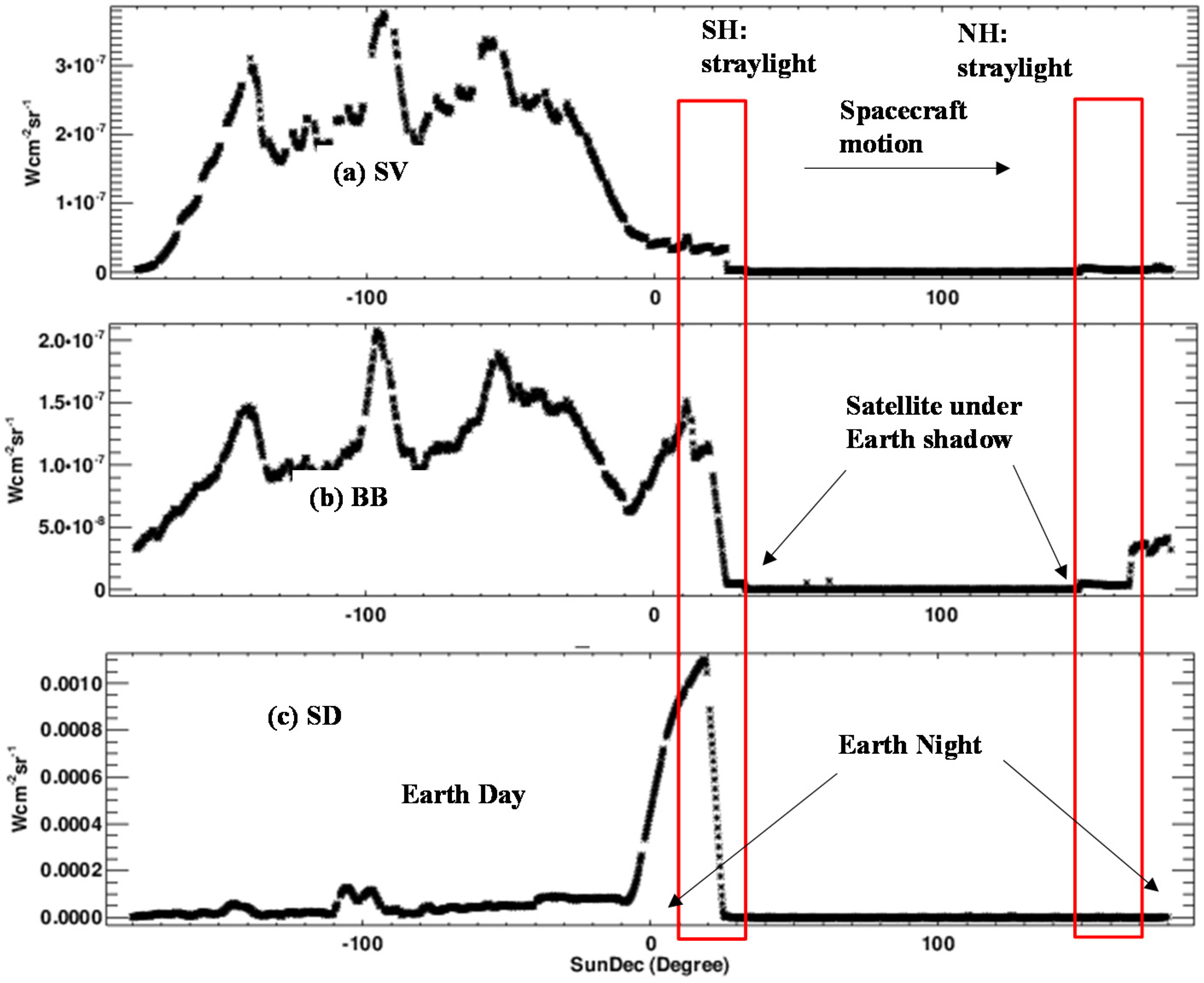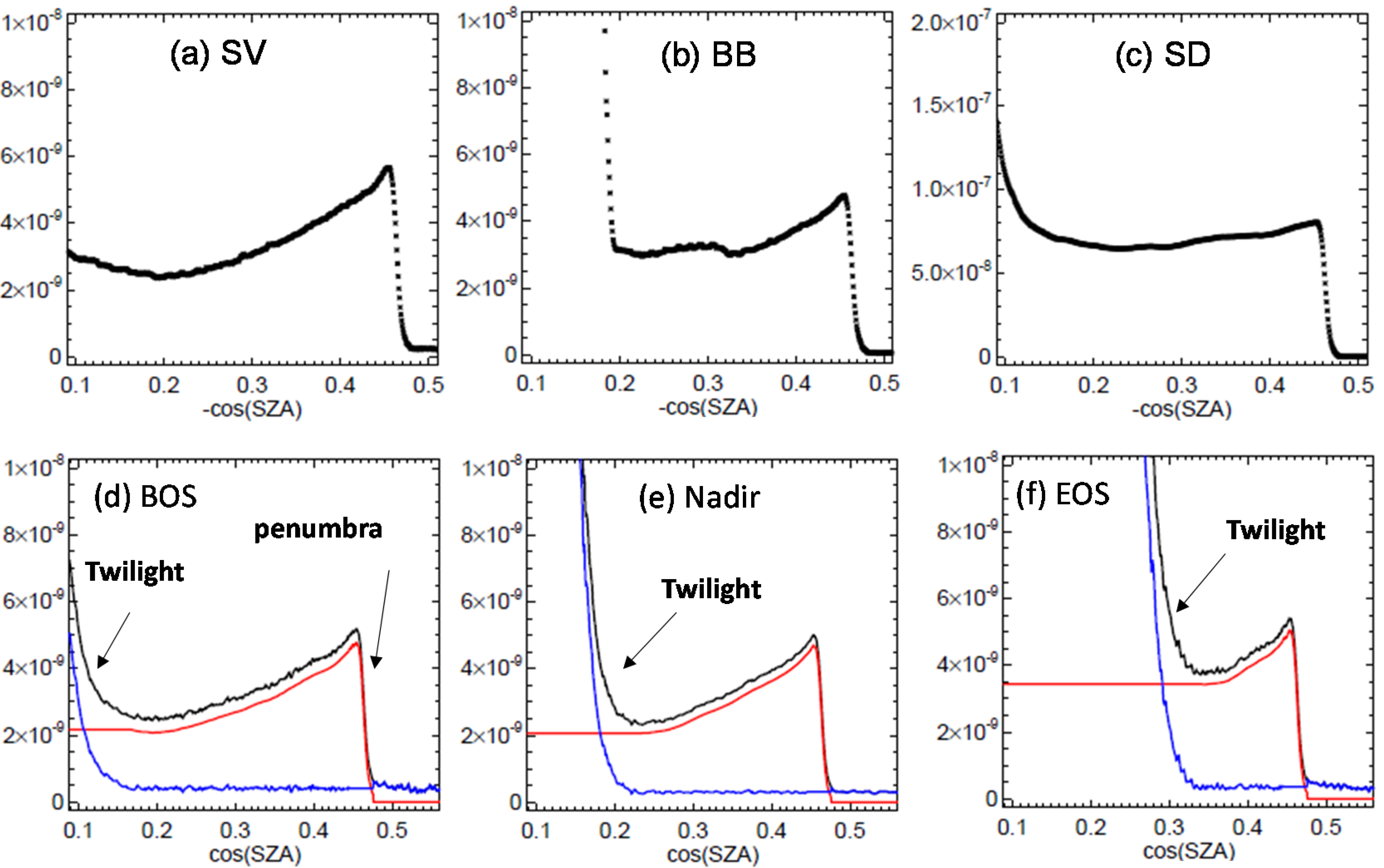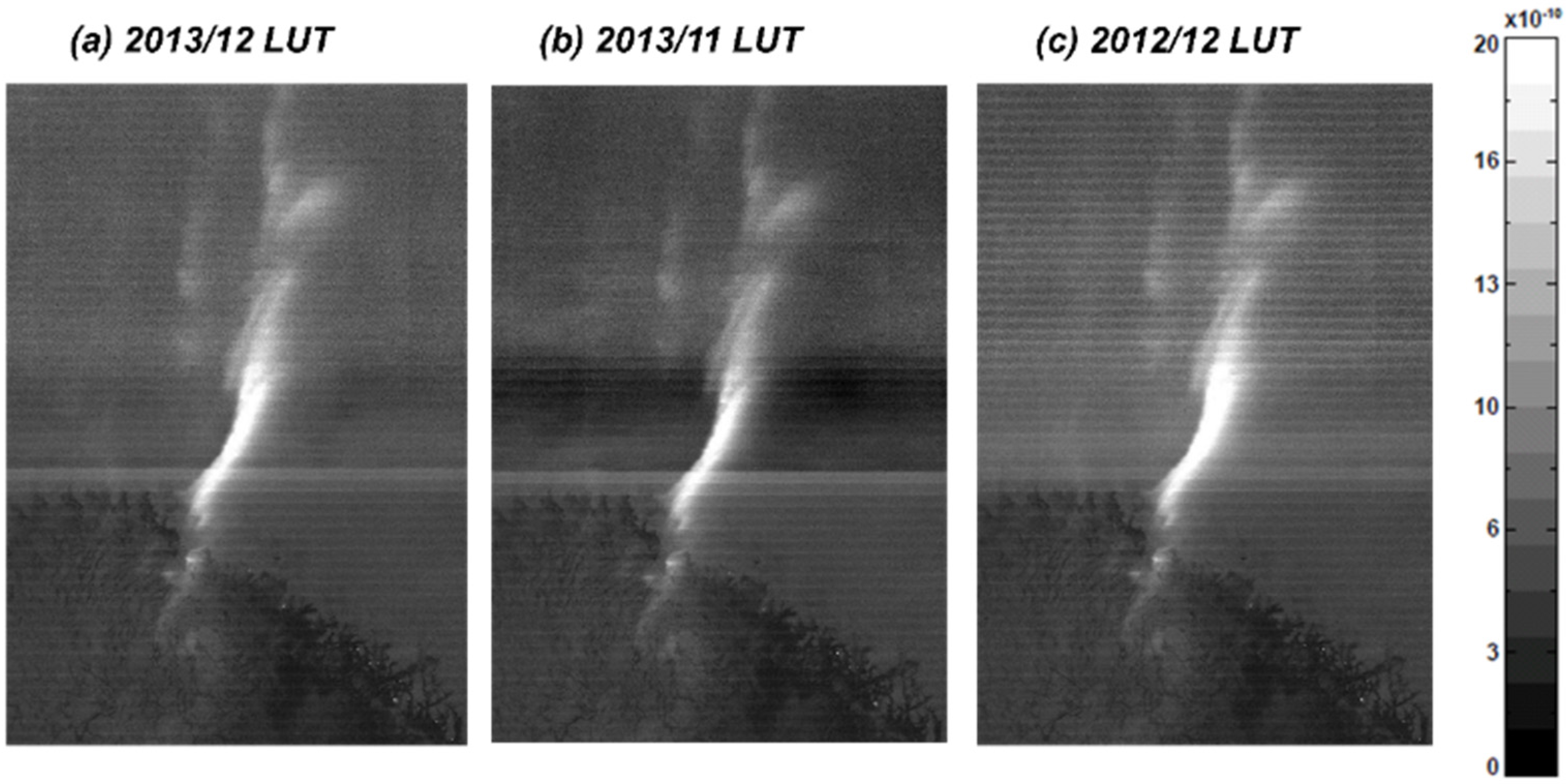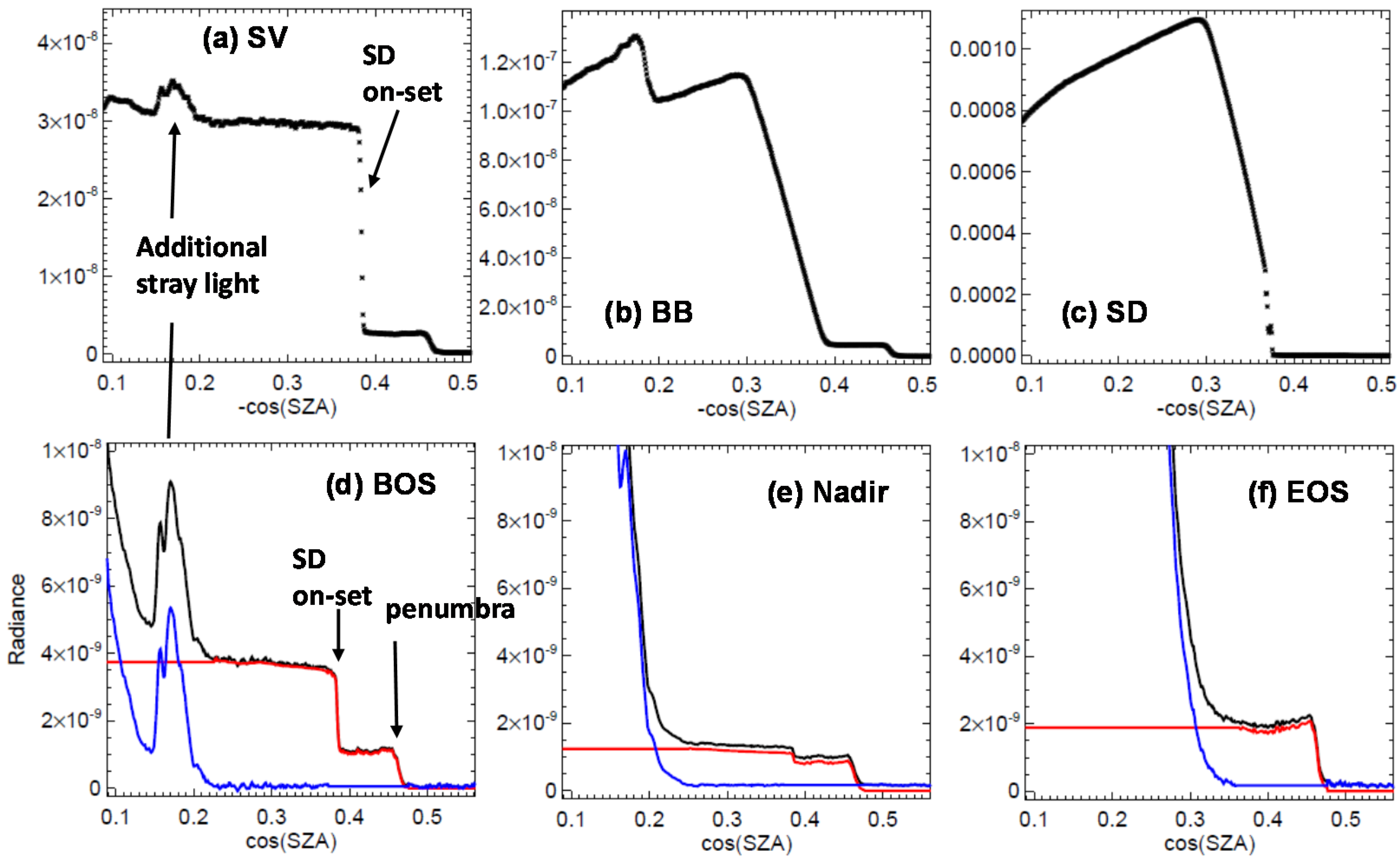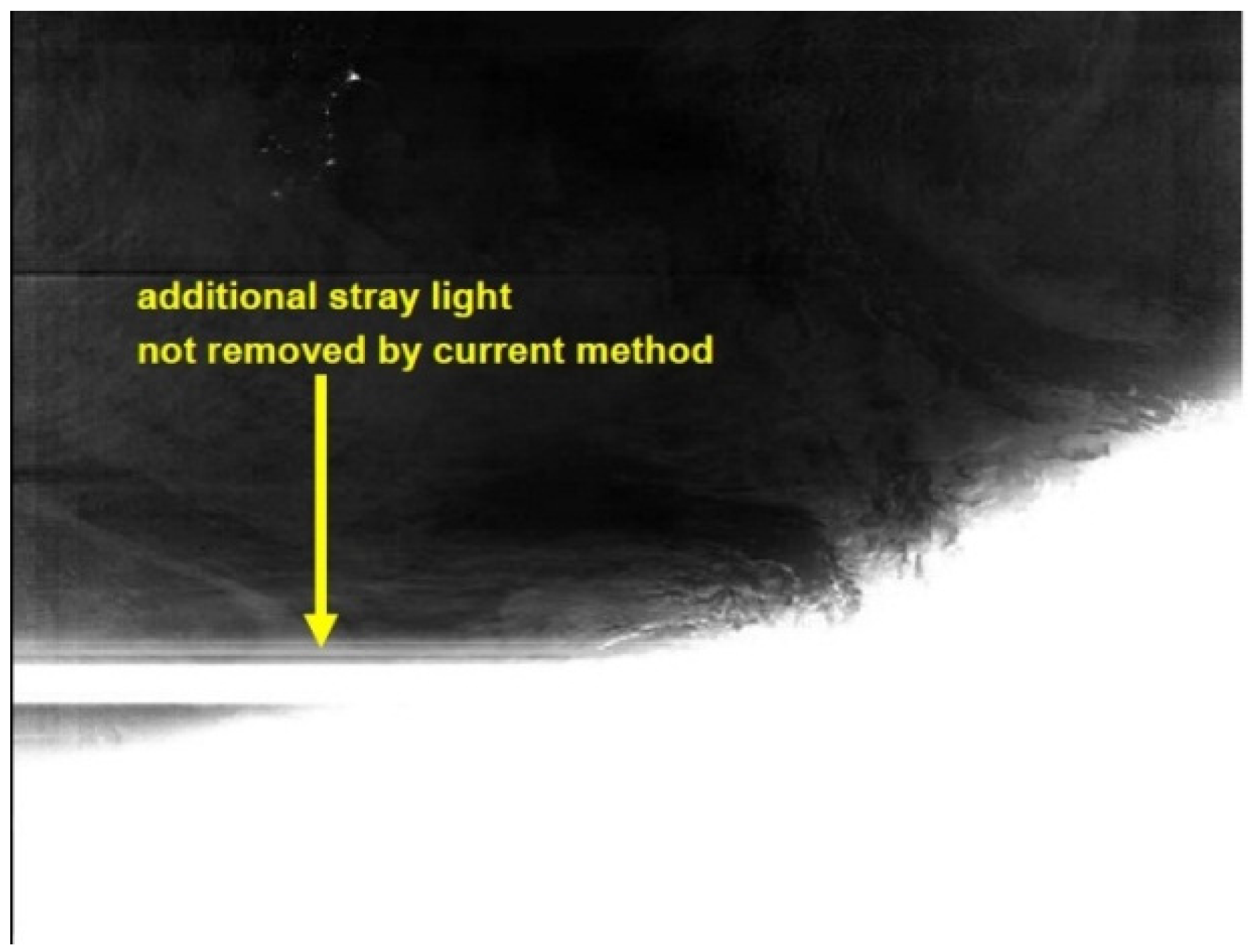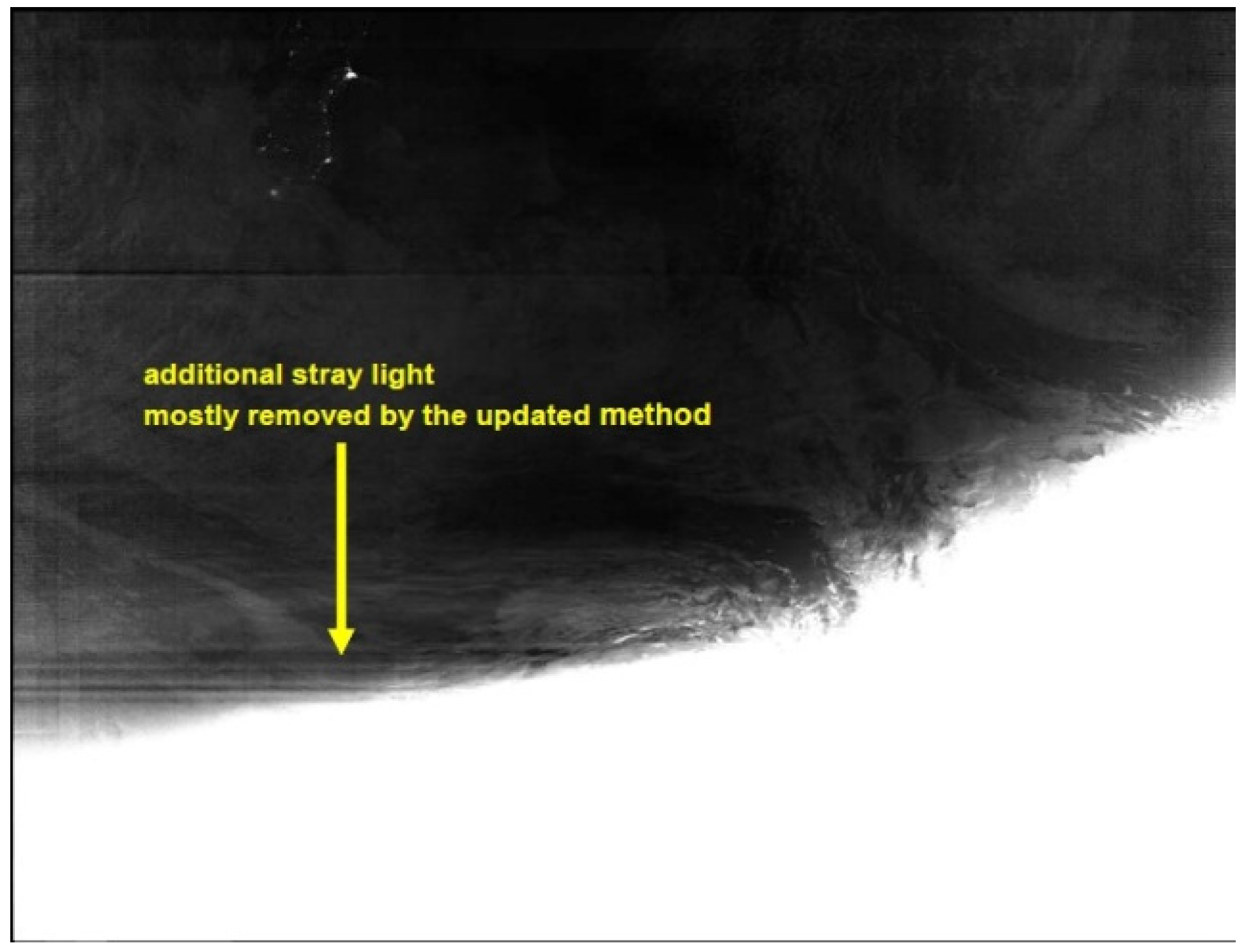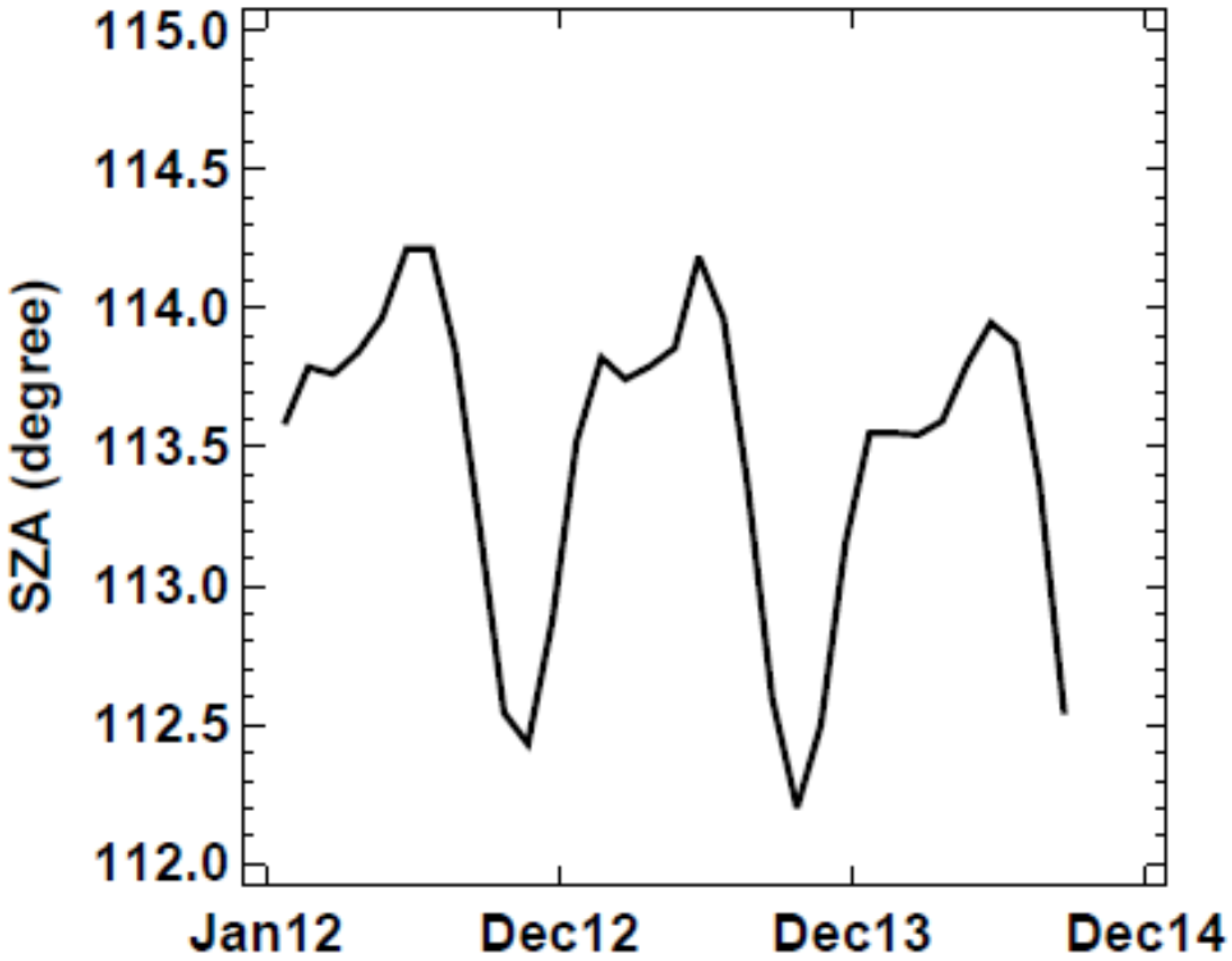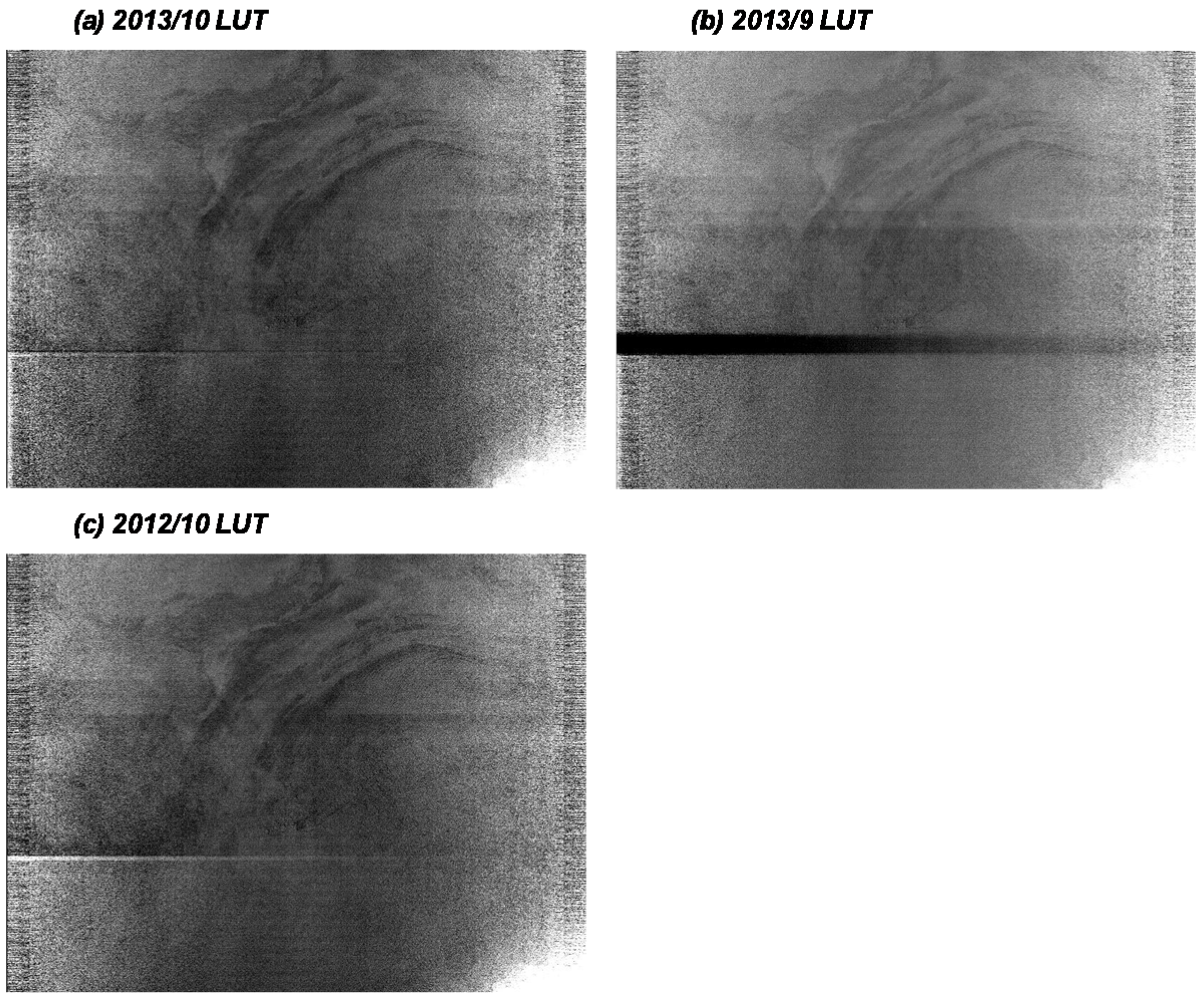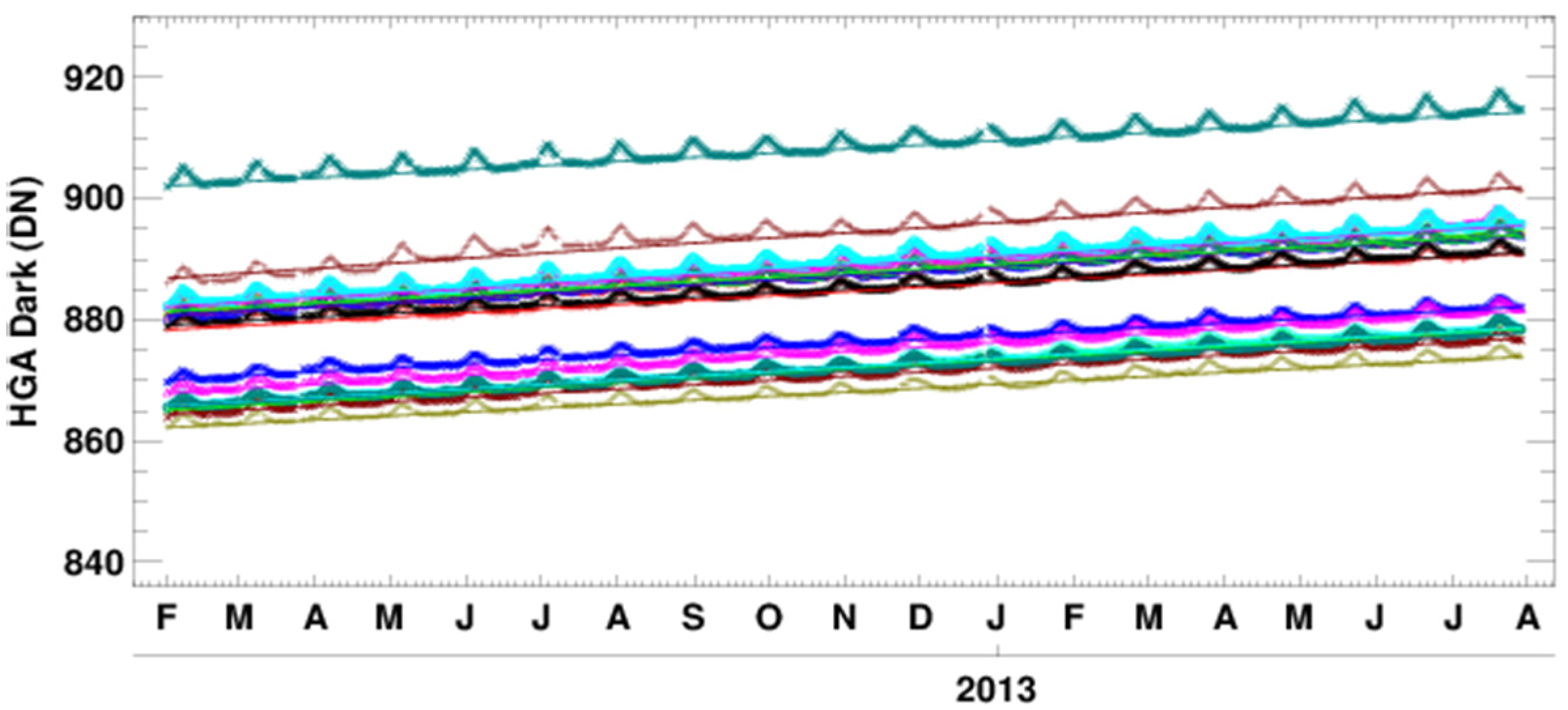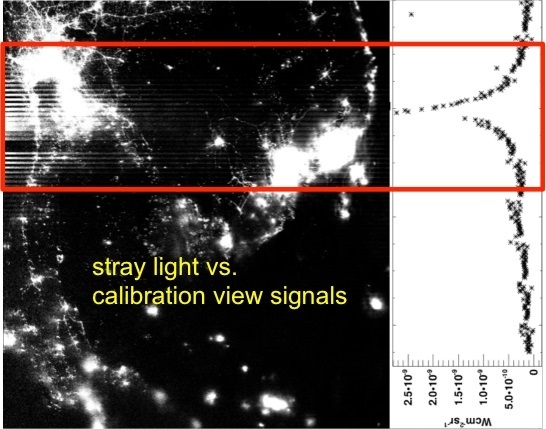3.1. Northern Hemisphere
Figure 4 shows the typical EV dark signals (d–f) in the northern hemisphere DNB EV stray light-affected regions and the corresponding calibration views signals (a–c). In the EV plots (d–f) the estimated stray light and mean signals after correction are also plotted in red and blue, respectively.
Figure 4 shows that both EV and calibration view signals increased sharply in the penumbra region, when the spacecraft is transitioning from the dark to the bright part of the orbit. The recorded SV signals are similar to the EV dark signals both in patterns and magnitude before the Earth scene enters the twilight region. Since SNPP is on a descending orbit and has a declination angle of ~100 degrees, the Earth scene at end of scan (EOS) will observe the twilight region earlier than the beginning of the scan (BOS). The result is shown in
Figure 4 as the sharp EV signal increase due to twilight happening at a lower solar zenith angle (SZA) at BOS (
Figure 4d) than at EOS (
Figure 4f). The BB signals also showed similar patterns to SV and EV from penumbra to SZA ≈ 108 degrees (−cos(SZA) ≈ 0.32), then the signals were slightly elevated before sharp increases at SZA ≈ 100 degrees (−cos(SZA) ≈ 0.18). The signal pause at SZA ≈ 108 degrees coincided with EOS twilight onset angle, indicating the increased Earth shine might have contributed slightly to BB signals. Similar to SV, BB, and EV, the SD signals show the initial sharp increase in the penumbra region, then a gradual decrease before increasing again at around BOS twilight onset angles when the Earth view entered the twilight region. The SD signals are at least an order of magnitude stronger than SV, BB, or EV, indicating the bulk of the signal likely is the reflected stray light off the SD surface.
Figure 4.
DNB detector 8 EV and calibration view dark signals near northern hemisphere stray light problem regions on October 5, 2013. (a–c) show calibration views. EV dark signals for beginning of scan (BOS), nadir, and end of scan (EOS) are shown in (d), (e), and (f), respectively. Black curves: dark signals; red curves: estimated stray light; blue curves: signals after stray light correction. SZA = solar zenith angle.
Figure 4.
DNB detector 8 EV and calibration view dark signals near northern hemisphere stray light problem regions on October 5, 2013. (a–c) show calibration views. EV dark signals for beginning of scan (BOS), nadir, and end of scan (EOS) are shown in (d), (e), and (f), respectively. Black curves: dark signals; red curves: estimated stray light; blue curves: signals after stray light correction. SZA = solar zenith angle.
The current operational stray light correction methods approximate the stray lights as the EV dark signals minus the airglow (red curves in
Figure 4d–f) approximated by the EV dark signals observed outside of the stray light affected regions [
16,
17]. In thre northern hemisphere, this method performed well in removing the bulk of the stray light, except for the penumbra regions. Since the sharp stray light increases with respect to SZA in the penumbra region, even a small mismatch in the penumbra onset angles between the imaging and LUT generation time could increase noticeable image artifacts after correction [
17]. The effects can be demonstrated in
Figure 5, where the same image is corrected using correction LUTs derived from three different months.
Figure 5 shows the corrected image using the current month’s LUT has the best quality (
Figure 5a), and the worst image (
Figure 5b) was corrected using the prior month’s LUT. To show the penumbra angle mismatch was the cause, we estimated the median penumbra angles in SV signal profiles (
Figure 6). Based on the estimated penumbra angles, the potential angle bias between the stray light correction LUTs and the scene in
Figure 5 is about 0.07 degrees for (b) and 0.02 degrees for (c). The larger penumbra angle bias results in worse image quality after correction.
Figure 6 shows that the estimated penumbra regions had an annual cycle with a magnitudes of ~0.2 degrees. The repeatable annual cycle indicates a prior year’s correction LUT will usually have a better match in penumbra angle than the prior month’s correction LUT. Without angular adjustment in correction LUT, a prior year’s correction LUT should perform better in forward operational processing when the most current month’s correction LUT is not available. The bias in penumbra angles could be further reduced if the yearly angular drifts are adjusted. For reprocessing when all historical correction LUTs are available, it is possible to temporally interpolate the penumbra onset angles to further reduce the correction residuals due to the minor penumbra angular drifts.
Figure 5.
Stray light corrected images for December 3, 2013, 7:43 GMT, using LUTs derived from (a) 2013 December; (b) 2013 November; and (c) 2012 December data.
Figure 5.
Stray light corrected images for December 3, 2013, 7:43 GMT, using LUTs derived from (a) 2013 December; (b) 2013 November; and (c) 2012 December data.
Figure 6.
Median penumbra angle estimated using DNB SV data. The angle is estimated as the maximum slope in SV signal profile.
Figure 6.
Median penumbra angle estimated using DNB SV data. The angle is estimated as the maximum slope in SV signal profile.
3.2. Southern Hemisphere
Figure 7 shows the EV and calibration view signal levels around the DNB EV stray light affected-regions in the southern hemisphere. In the penumbra region, EV and calibration view signals show an increase similar to what was observed in the northern hemisphere, but with a smaller magnitude. The BB and SV also showed similar patterns and magnitude as EV signals before the onset of solar calibration when additional solar illumination is coming through the SD screen. At the onset of solar calibration, both SV and EV signals showed a sudden jump that coincides with a signal jump in SD (
Figure 7c). After the signal jump, the SV signal is about one order of magnitude larger than the EV before it transitions into the twilight region. At the beginning of the solar calibration event, the SD signal gradually increased to reflect the increase in solar illumination on SD. The BB signals show a similar pattern to SD with a magnitude of four to five orders smaller.
Figure 7.
DNB detector 8 EV and calibration views dark signals near southern hemisphere stray light problem regions on October 5, 2013. (a–c) show calibration views. EV dark signals for beginning of scan (BOS), nadir, and end of scan (EOS) are shown in (d–f), respectively. Black curves are computed dark signals, red curves are estimated stray light, and blue curves are the signals after stray light correction. SZA = solar zenith angle.
Figure 7.
DNB detector 8 EV and calibration views dark signals near southern hemisphere stray light problem regions on October 5, 2013. (a–c) show calibration views. EV dark signals for beginning of scan (BOS), nadir, and end of scan (EOS) are shown in (d–f), respectively. Black curves are computed dark signals, red curves are estimated stray light, and blue curves are the signals after stray light correction. SZA = solar zenith angle.
Figure 7 data is taken when additional stray light features occurred in the southern hemisphere. Based on the current correction method, the large correction residual can be seen in
Figure 8, which shows that the additional stray light obscures the underlying scene structure. The additional stray light occurred near the twilight region and can be traced back to the elevated SV, BB, and EV dark signals (
Figure 7a,b,d). The mean corrected EV dark signal in
Figure 7d (blue curve) shows the additional stray light remains within the corrected signals. For comparison, the SV, BB, and EV dark signals for September, 2013 (
Figure 9) did not show the corresponding additional stray light features in SV. The current method relies on extrapolation to estimate the stray light in the twilight region due to the difficulty of separating stray light signals from Earth radiance [
16,
20]. The current method had been proven to work well roughly nine months of the year when there are no additional stray light features. The blue curve in
Figure 9 shows no obvious artifact after correction. However, a different method would be required to remove this additional stray light feature.
Figure 8.
DNB image from October 5, 2013, 5:06 GMT, corrected by the current method. The residual artifact from additional stray light can be seen as a large swath across the image.
Figure 8.
DNB image from October 5, 2013, 5:06 GMT, corrected by the current method. The residual artifact from additional stray light can be seen as a large swath across the image.
Figure 9.
DNB detector of eight dark signals near the southern hemisphere stray light problem regions on September 5, 2013 for (a) SV; (b) BB; and (c) EV at BOS. Black curves are computed dark signals, red curves are estimated stray light, and blue curves are the signals after stray light correction. SZA = solar zenith angle.
Figure 9.
DNB detector of eight dark signals near the southern hemisphere stray light problem regions on September 5, 2013 for (a) SV; (b) BB; and (c) EV at BOS. Black curves are computed dark signals, red curves are estimated stray light, and blue curves are the signals after stray light correction. SZA = solar zenith angle.
To estimate the additional stray light contamination, the current correction method is modified in the twilight region. First, the angular extent of the additional stray light is estimated from SV signals (
Figure 7). Then, the expected EV dark signals are estimated based on an exponential fit using data outside of the additional stray light region. The additional stray light is then approximated as the difference between the computed EV dark signals and the approximated EV dark signals. The stray light estimates outside of the new regions identified by SV data remain the same as the current method, in which extrapolated values were used. Based on this updated method,
Figure 10 shows the computed EV dark signals, estimated EV stray light, and the expected EV dark signals after stray light correction. Compared with the current method (
Figure 7), the updated method was able to estimate the bulk of the additional stray light even within the twilight region. Notice that the estimated additional stray light features were at the onset of twilight at BOS, completely within the twilight at nadir, and nonexistent at EOS, as the additional stay light becomes insignificant to EV signals.
Figure 10.
DNB EV dark signals near the southern hemisphere stray light problem regions on October 5, 2013. (a–c) show EV dark signals for beginning of scan (BOS), nadir, and end of scan (EOS), respectively. Black curves are computed dark signals, red curves are estimated stray light based on the updated method, and blue curves are the signals after stray light correction. SZA = solar zenith angle.
Figure 10.
DNB EV dark signals near the southern hemisphere stray light problem regions on October 5, 2013. (a–c) show EV dark signals for beginning of scan (BOS), nadir, and end of scan (EOS), respectively. Black curves are computed dark signals, red curves are estimated stray light based on the updated method, and blue curves are the signals after stray light correction. SZA = solar zenith angle.
To test the updated method, we applied the updated stray light estimates to
Figure 8 and generated the updated DNB stray light corrected image for comparison. The updated DNB stray light corrected image (
Figure 11) shows that the bulk of the additional stray light is removed with some correction residuals. Compared with the current image (
Figure 8), the updated image reveals additional features under the prior additional stray light contamination region with the well-defined twilight transition across the image. The additional stray light region slices through the twilight transition zones, which complicates the stray light estimation due to the overlapping of stray light and twilight signals. As shown in
Figure 7, the additional stray light is clearly identified at BOS, but is partially embedded in the twilight at nadir. At EOS, the additional stray light becomes insignificant when compared with the Earth scene radiance. The result indicates that the updated correction method successfully entangled the stray light features from the twilight, as the corrected image (
Figure 11) did not show strong scan angle-dependent residual biases.
Figure 11.
DNB image from October 5, 2013, 5:06 GMT, corrected by the updated method. The residual artifact from additional stray light is significantly reduced.
Figure 11.
DNB image from October 5, 2013, 5:06 GMT, corrected by the updated method. The residual artifact from additional stray light is significantly reduced.
The southern hemisphere stray light correction experienced a similar penumbra angle mismatch issue discussed earlier in the northern hemisphere stray light correction. Furthermore, a much larger angle mismatch could come from the onset of the SD angle as its temporal drift is much larger. To track the temporal drift, we estimated the onset of the SD angle using the signal jumps in the SV data (see
Figure 7a). The estimated SD onset angles (
Figure 12) show an annual oscillation of about two degrees, an order of magnitude larger than the penumbra’s angular cycle. The large angular drift indicates the importance in selecting stray light correction LUT to avoid a significant correction error due to bias in the SD onset angles.
Figure 13 shows the image corrected using the prior month’s LUT has significant overcorrection (black strip in
Figure 13b) due to the bias in the SD onset angle. The image corrected using the prior year’s LUT (
Figure 13c) showed a more comparable result with correction performed with the current month’s LUT (
Figure 13a).
Figure 12.
SD onset angle estimated using DNB SV data.
Figure 12.
SD onset angle estimated using DNB SV data.
Figure 13.
Stray light corrected images for October 5, 2013, 1:41 GMT, using LUTs derived from (a) 2013 October; (b) 2013 September; and (c) 2012 October data.
Figure 13.
Stray light corrected images for October 5, 2013, 1:41 GMT, using LUTs derived from (a) 2013 October; (b) 2013 September; and (c) 2012 October data.
3.4. Background Stray Light from the Moon
The operational VIIRS DNB EV dark offset is determined once a month via a special operation [
25]. The dark offset is determined using data collected over the dark ocean during each month’s new moon. Studies have shown the dark ocean scenes are not sufficiently dark to set the DNB HGS offset for the nighttime due to airglow and the biases that could be up to 8 × 10
−10 W·cm
−2·sr
−1 [
15,
20]. One solution is to use an airglow-free dark reference derived from the spacecraft pitch maneuvers’ deep space scene and track the dark offset drift from the BB signals [
17]. However, the BB nighttime signal trending (
Figure 16) showed periodic bumps that are found to be correlated with Moon illumination. To remove the periodic stray light from the Moon, the dark drifts are fitted using the BB data near new moon, and the fitted values are used to adjust dark offset derived from pitch maneuver data [
17].
Figure 16.
DNB BB daily mean dark signal DN for HGA, aggregation mode 1. The measured values for each detector are represented by symbols. The lines are fitted values using new moon data. The periodic increase in DN corresponded to the increase in lunar illumination. At full moon, the dark response is up to 5 dn (~ 8 × 10−11 W·cm−2·sr−1) higher than the new moon.
Figure 16.
DNB BB daily mean dark signal DN for HGA, aggregation mode 1. The measured values for each detector are represented by symbols. The lines are fitted values using new moon data. The periodic increase in DN corresponded to the increase in lunar illumination. At full moon, the dark response is up to 5 dn (~ 8 × 10−11 W·cm−2·sr−1) higher than the new moon.
Although this method provided a dark offset that is free from Moon contamination, it is uncertain if, and how much of, the Moon stray light affects EV observation. Based on the stray light analysis and its corresponding EV and calibration views signal features presented earlier, the stray light signals in BB suggest similar effects in EV data. If the Moon stray light observed in BB is, indeed, elevating background signal levels for EV observations, then the EV dark offset should be adjusted based on Moon illumination. The EV and BB relationships presented earlier (
Figure 4 and
Figure 7) indicated that the EV stray light is at a similar level of BB signal. In
Figure 16, the Moon stray light observed in BB is less than 8 × 10
−11 W·cm
−2·sr
−1, which is just below the usable DNB radiance of 10
−10 W·cm
−2·sr
−1 [
15], and much smaller than the typical airglow. If the Moon stray light causes similar background signal increase in EV as in BB, the impact on DNB imagery quality will be minimal. The potential impact would only be in the airglow over dark surfaces, e.g., oceans, as most other surfaces will have radiance much higher than the Moon stray light.

